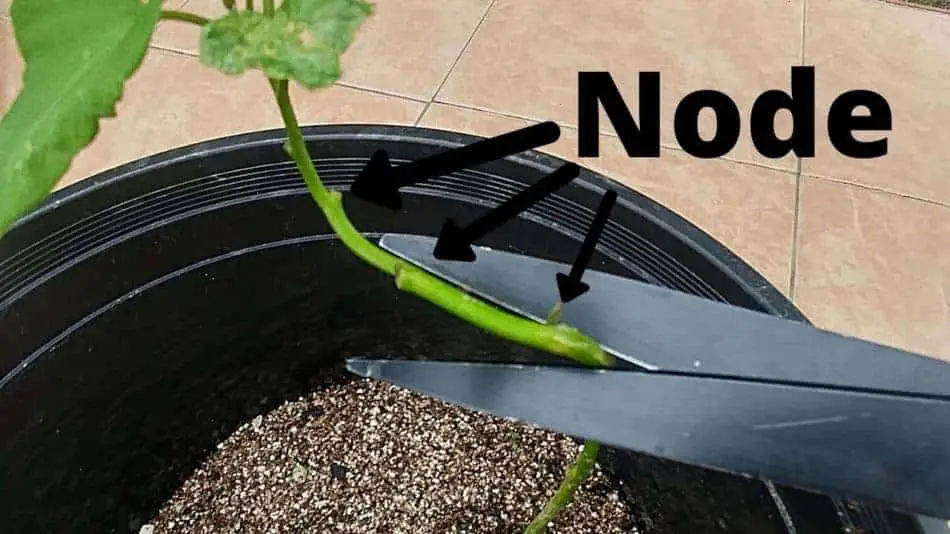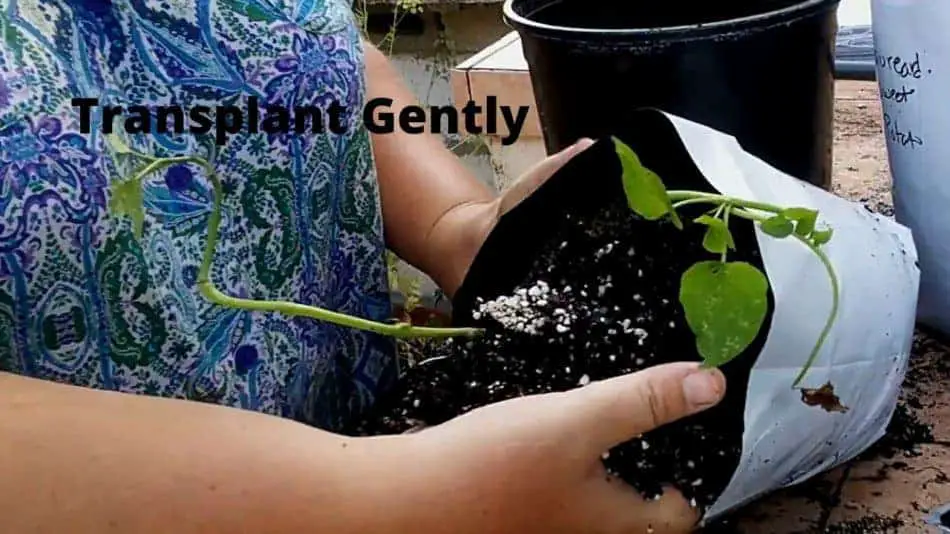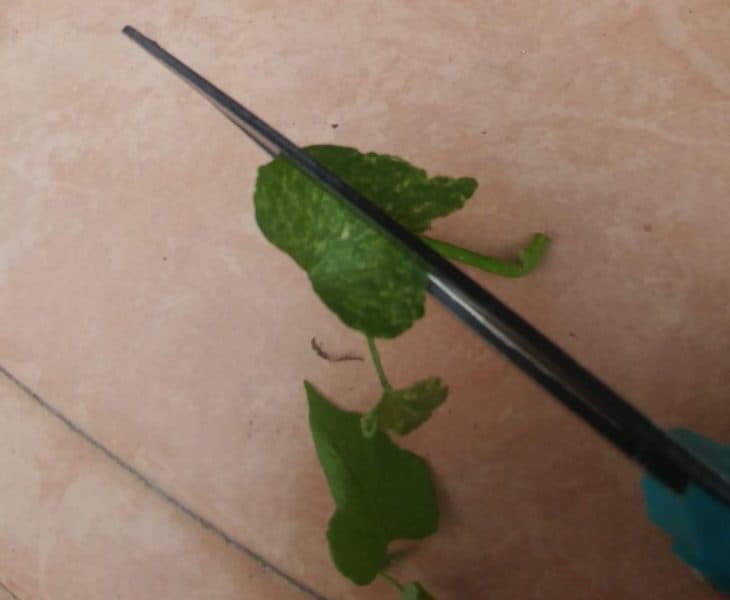I have been propagating plants for decades and sweet potato vines are a good plant to start your vegetative propagation journey with.
To grow sweet potatoes from cuttings, follow these illustrated steps:
Cut a piece off your growing vine at least 3 nodes long, more is fine.

It is best to use clean, sterile, and sharp tools for this, I use household scissors or pruners. If making a lot of cuttings when it is important to watch for disease, either wipe with a sanitizer wipe or rubbing alcohol to prevent any possible disease transmission.
Remove leading bud, snip tip right off.

The lead bud sends out hormone signals telling the other buds to remain dormant. If it is removed, such as when deer are browsing, the other buds come out of dormancy to grow. By removing that lead bud, you remove that hormone signal, halting the signal to stay dormant, and prime the other buds to start growing whatever is needed, including roots.
Remove most of the leaves, trim any remaining leaves.
During the time the plant is growing new roots, the leaves will continue to lose water, removing vital water from the plant stem and buds. Removing the leaves conserves the cutting’s moisture until new roots grow to uptake water again.
Place cutting in potting soil, vermiculite, or water.
Rooting hormone is not needed for Ipomea slips (cuttings). I prefer to use vermiculite for cuttings, it is light, holds a lot of water, and is sterile. Potting soil is my next choice. Water can be used, but the roots that grow in water are not adapted for soil and need to regrow new roots for soil when transplanted. I skip past this step by rooting directly in soils instead of water.


Click here for the best coco coir potting soil from Amazon, great for cuttings and even moisture on your houseplants!
Keep humidity high and soil warm.
High humidity is also preventing transpiration and conserve moisture. Warm soil promotes root growth. You can either take your cutting when it is reliably above 60 degrees F at night or use a heating pad. Humidity can be maintained using a humidity dome, or a clear plastic bag. Light, rather than darkness increases rooting. Do not put in direct sun, which would heat up the bag and cook the cuttings, but the indirect light of most windowsills. The dome is best as you do not have the plastic touching the cuttings encouraging rot, which is the major cause of failure in cuttings rooting.



Humidity dome and a heating mat you will use time and time again. Once you have them you will be surprised how often you use these for much more than the standard rooting cuttings, also seed starting. I even have used my heat mat in bread rising and yogurt making! Click here to see which humidity dome I use, and here to see my favorite heat mat.
Wait 1-2 weeks
This is the hardest part, do not keep pulling on the cuttings to see if you see roots yet, you will damage newly forming roots. Wait until you see new growth from the cutting above the soil. That is your signal that you have some roots and your cuttings are ready to transplant.
Transplant rooted cutting into either your pot, or your soil bed.

After you see new growth, transplant gently into a pot with potting soil or into your garden bed. To find out how to choose the best spot for your new sweet potato plant to grow, check out Speed Dating for You and Your Plants. Keep shaded for another week while your new plant gains strength and becomes accustomed to stronger light. Fertilize lightly with ¼ strength water-soluble fertilizer once a week when you water. How to water container plants? Find out more here. Whichever fertilizer you choose, organic or conventional, use it at a much-reduced strength until your plant is growing robustly.

To encourage bushy growth, prune off the leading tip bud again to encourage the side buds to grow.
This method works equally well for both ornamental sweet potato vines and edible sweet potatoes.

Related Questions:
Can Sweet potato vines root in water?
Sweet potato vines can be rooted in water, I prefer to root in vermiculite or potting soil. The roots that are sprouted in water are adapted to grow best there, and when you transplant them into the soil, the plant needs to start again growing soil roots.
Can sweet potato vines root in the soil?
Sweet potato vines can root directly into the soil, I prefer potting soil or vermiculite, as I get more cuttings to root successfully this way. Directly into your garden will result in a much lower success rate. Do shade the new cutting area, and be sure it stays moist. If you have plenty of cuttings go ahead and root directly in the soil to see what success you have. Warm sandy soils are much more successful than clay soils.
How long does it take to root sweet potato vines?
Sweet potatoes root very quickly, as quickly as 1 week, with warmth. Planning on 2 weeks to be certain.
Do you have to cover cuttings with a bag?
Cuttings root better with a covering to increase humidity, but if your weather is warm and humid, this step is not necessary.
Do cuttings need light to root?
Cuttings root better with light, as opposed to darkness. Not strong direct sun, just general indirect light. Do not put your cuttings in the direct sun, you will cook them rather than rooting them.
Why do cuttings fail?
Cuttings most often fail to root due to rot setting in the cutting, the cutting dried out, or there was not enough energy stored in the cutting to grow new roots and buds. Some plants do not start new roots from bud areas as easily as others, and Rooting Hormone is needed to encourage that growth to start. Rooting cuttings is not guaranteed for any plant, they simply will not all root, but the faster growing the plant, the easier it is to root from a cutting.
Should I use rooting hormone?
Rooting hormone is best used on hardwood cuttings and slow to root cuttings. Hardwood cuttings are taken from trees and shrubs from hardened new growth. That is when the growth has taken on the appearance of mature plant growth rather than fresh, young actively growing spring growth. Slow-growing plants also are a good time to use the rooting hormone. These plants simply do not grow as fast, and the cells are not so quick to change gears to growing roots.



Sweet Potato slips vs cuttings.
Sweet potato slips and cuttings are two different terms for the same thing. Tomaaato..tomahhto.
https://www.missouribotanicalgarden.org/gardens-gardening/your-garden/help-for-the-home-gardener/advice-tips-resources/visual-guides/rooting-cuttings-in-water.aspx



